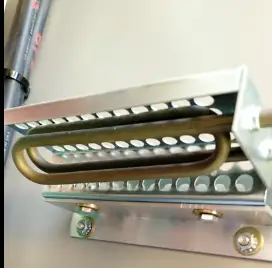Electric motors play a crucial role in various industries and applications, powering machinery and equipment.
However, these motors are vulnerable to certain electrical disturbances, including overvoltage. Overvoltage occurs when the voltage supplied to the motor exceeds its rated voltage, potentially leading to significant damage if left unchecked.
Yes, overvoltage can damage electric motors by causing increased temperature, insulation breakdown, bearing wear, and control circuitry damage.
In this article, we will explore the effects of overvoltage on electric motors, signs of damage to look out for, preventive measures, and real-world case studies.
Table of Contents
Understanding Overvoltage
Overvoltage refers to a situation where the voltage supplied to electrical systems exceeds their normal operating range.
It can be caused by factors such as power grid fluctuations, lightning strikes, equipment malfunctions, or switching operations.
The effects of overvoltage on electrical systems can be severe, leading to insulation breakdown, overheating, component failure, and reduced lifespan.
Electric Motor Fundamentals
Before delving into the impact of overvoltage on electric motors, let’s understand their basic principles.
Electric motors convert electrical energy into mechanical energy, enabling the rotation of machinery.
They consist of various components, including the stator (stationary part), rotor (rotating part), windings, bearings, and control circuitry.
Overvoltage and Electric Motors
Overvoltage can have detrimental effects on electric motors, particularly on their windings, bearings, control circuitry, efficiency, and overall performance.
Can overvoltage damage electric motors?
Yes, overvoltage can indeed cause damage to electric motors. When the voltage supplied to an electric motor exceeds its rated voltage, it can lead to several detrimental effects.
These effects include increased temperature in the motor windings, which can result in insulation breakdown and reduced motor efficiency.
Overvoltage can also cause premature wear and failure of motor bearings, as well as damage to the control circuitry of the motor.
Overall, overvoltage poses a significant risk to the performance, reliability, and lifespan of electric motors.
Implementing preventive measures, such as voltage regulation, surge protection, and proper grounding, is crucial to protect electric motors from overvoltage damage.
Overvoltage Impact on Electric Motor Windings
One of the primary areas affected by overvoltage is the motor windings. Increased voltage can lead to thermal effects, causing the windings to heat up beyond their design limits.
This can result in insulation degradation, reduced motor efficiency, and potential insulation breakdown.
Insulation breakdown poses a significant risk to the motor’s operation and may require costly repairs or replacement.
Thermal effects on motor windings: Overvoltage causes excessive heating of the windings, leading to insulation deterioration and decreased motor performance.
This can manifest as increased temperature, reduced insulation resistance, and decreased overall motor efficiency.
Insulation breakdown and degradation: Overvoltage weakens the insulation materials in motor windings, compromising their ability to withstand electrical stress.
Over time, this can lead to insulation breakdown, short circuits, and ultimately, motor failure.
Overvoltage Impact on Motor Bearings
Electric motor bearings are also susceptible to damage from overvoltage. High voltage levels can cause electrical discharge within the bearings, leading to premature wear, increased friction, and potential bearing failure.
Damaged bearings can result in excessive vibration, noise, and decreased motor performance.
Overvoltage Impact on Motor Control Circuitry
The control circuitry of electric motors, including electronic components and motor drives, is vulnerable to overvoltage.
Excessive voltage can damage sensitive electronic components, disrupt control signals, and lead to erratic motor operation or complete system failure.
Protecting the control circuitry is essential to ensure the reliable and safe operation of electric motors.
Overvoltage Impact on Motor Efficiency and Performance
In addition to the specific effects on windings, bearings, and control circuitry, overvoltage can impact the overall efficiency and performance of electric motors.
Increased voltage levels can result in higher power consumption, reduced energy efficiency, and decreased output power.
This not only leads to increased operating costs but can also affect the performance and productivity of the machinery or equipment powered by the motor.
Signs and Symptoms of Overvoltage Damage
Detecting overvoltage damage early is crucial to prevent further deterioration and minimize repair costs. Here are some signs and symptoms to look out for:
- Visible signs of damage: Inspect the motor for burned insulation, melted components, or discoloration, indicating possible overvoltage damage.
- Abnormal motor behavior: Pay attention to excessive noise, vibration, or erratic operation, as these may indicate overvoltage-related issues.
- Increased power consumption: Monitor the motor’s energy usage and note any significant increase, which could be a sign of overvoltage damage.
Read also my article: Electric Motor Woes: What Causes Winding Burnout and How to Fix It
Preventing Overvoltage Damage
Protecting electric motors from overvoltage requires proactive measures and preventive strategies. Here are some effective methods:
Voltage Regulation and Stabilization Techniques
- Voltage regulators: Installing voltage regulators helps maintain a consistent voltage supply to electric motors, compensating for voltage fluctuations and ensuring optimal performance.
- Surge protectors: Employing surge protectors safeguards electric motors against voltage spikes and transients caused by lightning strikes or sudden power surges.
Electrical System Design Considerations
- Proper sizing: Design electrical systems appropriately, ensuring that components are sized correctly to handle the expected voltage levels and prevent overvoltage situations.
- Protective devices: Incorporate protective devices, such as circuit breakers and fuses, to interrupt the power supply in case of voltage abnormalities and protect the motor from damage.
- Voltage monitoring and control: Implement voltage monitoring devices to detect and alert users of potential overvoltage conditions, allowing for timely intervention.
Read also my other article: Unveiling the Shocking Impact: How Overvoltage Harms Motors.
Proper Grounding and Bonding
- Grounding systems: Establish proper grounding to provide a low-impedance path for fault currents, reducing the risk of overvoltage and ensuring electrical safety.
- Bonding systems: Implement bonding to prevent voltage potential differences between conductive parts, minimizing the risk of electrical shocks and equipment damage.
Mitigating Overvoltage Effects
Regular maintenance, monitoring, and the use of protection devices are crucial in mitigating the effects of overvoltage:
- Regular maintenance and inspections: Conduct routine maintenance checks to identify and address potential overvoltage issues, including verifying the integrity of the insulation, cleaning, and lubricating bearings, and ensuring proper connections.
- Monitoring and protection devices:
- Voltage monitoring relays: Employ voltage monitoring relays to continuously monitor voltage levels and trigger protective actions when the overvoltage occurs, such as activating alarms or initiating a shutdown sequence.
- Motor protection relays: Install motor protection relays that provide comprehensive protection against various electrical faults, including overvoltage. These relays can detect abnormal voltage conditions and take appropriate actions to safeguard the motor.
Conclusion
Overvoltage can cause significant damage to electric motors, affecting their windings, bearings, control circuitry, efficiency, and overall performance.
Detecting early signs of damage and implementing preventive measures are vital in safeguarding electric motors from overvoltage-related issues.
By employing voltage regulation techniques, proper system design, and effective monitoring, industries can mitigate the risks, extend motor lifespan, and ensure the reliable operation of their machinery and equipment.
Don’t Leave Empty-Handed!
Install my Free Android App on Google Play:
Electrical Cables Most Common Tables “Cables Tables”
And, my Electrical Calculations App “Fast Electrical Calculator”
Discover more great content by subscribing to My channel
Looking to stay ahead of the game in the world of electrical engineering? Subscribe to my YouTube channel and gain access to exclusive content you won’t find anywhere else!
The staff I recommend
(Amazon Affiliate Links to products I believe are high quality):
- Economy 120 Volt/60Hz AC Power Source – Step-Down Voltage & Frequency Converters 1800W
- UNI-T Digital Multimeter Tester UT139C
- 50-Amp Extension Cord for RV “100ft”
- Voltage Stabilizer 110/220v
- Hair Dryer “best selling“
- TOSHIBA EM131A5C-BS Countertop Microwave Ovens
Disclaimer: This contains affiliate links to Amazon products. I may earn a commission for purchases made through these links.



